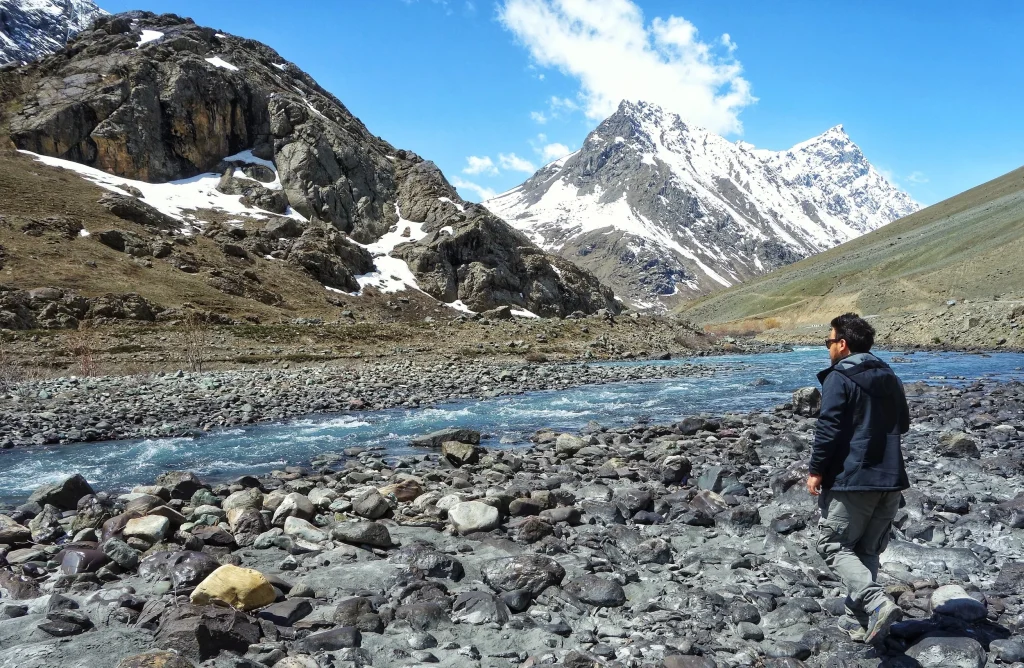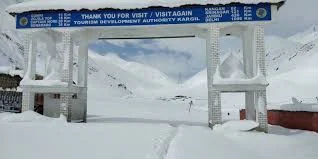Drass in Ladakh: The Second-Coldest Inhabited Place on Earth
Drass in Ladakh is a mesmerizing high-altitude town known for its extreme weather and breathtaking landscapes. Located at 3,300 meters, it is famously recognized as the second-coldest inhabited place on Earth, where winter temperatures drop as low as -40°C. Situated 60 km from Kargil on the Srinagar-Leh Highway (NH1), Drass serves as the Gateway to Ladakh, welcoming travelers with its stunning valleys and historic significance. The town played a key role in the 1999 Kargil War, making the Kargil War Memorial a must-visit attraction. Apart from its historical relevance, Drass in Ladakh offers scenic trekking routes, serene rivers, and breathtaking mountain views. The best time to visit is May to October when roads remain open and the weather is pleasant.
Book here our Ladakh Tour Package
Discover the Untamed Beauty of Drass Valley
Drass Valley in Ladakh is a breathtaking destination known for its rugged terrain, snow-clad peaks, and extreme weather conditions. Situated at 3,300 meters, it is often called the “Gateway to Ladakh” and is the second-coldest inhabited place on Earth. Despite its harsh winters, Drass captivates visitors with its lush green meadows, pristine rivers, and majestic mountain views during the summer. The valley is also historically significant due to its role in the 1999 Kargil War, with the Kargil War Memorial standing as a tribute to fallen heroes. Adventure enthusiasts can explore trekking trails, visit Tiger Hill, and experience the beauty of Mushkoh Valley. To witness the untamed beauty of Drass Valley, visit between May and October when nature is at its finest.
Top places to visit in Drass Valley Ladakh
1. Kargil War Memorial

The Kargil War Memorial is a tribute to the brave soldiers who fought in the 1999 Kargil War. Located in Drass, this site features the Flame of Eternal Glory, war artifacts, and names of martyrs engraved on stone walls. The museum inside showcases letters, weapons, and photographs from the war, making it a must-visit for history enthusiasts. Surrounded by the majestic Tiger Hill, this memorial fills every visitor with a sense of patriotism and pride.
2. Tiger Hill

One of the most famous peaks in Drass in Ladakh, Tiger Hill, played a crucial role during the Kargil War. Standing tall at 5,307 meters, it offers breathtaking panoramic views of the Himalayas. Trekkers and adventure lovers are drawn to its rugged beauty and historical significance. The journey to Tiger Hill provides a thrilling experience, with scenic landscapes along the way.
3. Mushkoh Valley

Known for its picturesque landscapes and vibrant wildflowers, Mushkoh Valley is a paradise for nature lovers. Once a battlefield during the Kargil War, the valley has now become a peaceful retreat. It is perfect for trekking, photography, and spotting rare Himalayan wildlife. The valley remains lush and colorful during the summer, attracting travelers looking for serenity and adventure.
4. Drass River

Flowing through the valley, the Drass River adds to the region’s scenic charm. The crystal-clear waters, surrounded by rugged mountains, create a perfect spot for nature walks and photography. Visitors can relax by the riverbanks and soak in the tranquility of Ladakh’s untouched beauty. The river also serves as an important water source for local villages, enhancing the valley’s natural appeal.
5. Minamarg

A hidden gem near Drass, Minamarg is famous for its lush green meadows, snow-capped peaks, and peaceful ambiance. It serves as a base for treks to Zoji La Pass, one of the most challenging and scenic mountain passes in Ladakh. Ideal for travelers looking for solitude, Minamarg is a great escape into nature. The landscape transforms into a paradise during summer, with blooming flowers and fresh mountain air.
Drass Valley Weather
Drass Valley in Ladakh is known for its extreme weather conditions, with freezing winters and mild summers. It is the second-coldest inhabited place on Earth, experiencing heavy snowfall and sub-zero temperatures for most of the year.
1. Summer (May to September): The best time to visit, with temperatures ranging from 15°C to 25°C during the day and 5°C to 10°C at night. The valley is lush and perfect for sightseeing and trekking.
2. Autumn (October to November): Temperatures drop to 0°C to -10 °C, and nights become extremely cold. The landscapes turn golden, offering a stunning view before winter sets in.
3. Winter (December to March): The harshest season, with temperatures plummeting to -40°C or lower. Heavy snowfall covers the valley, making travel difficult but creating a surreal winter wonderland.
4. Spring (April): The snow starts melting, and temperatures rise from 0°C to 10°C, though nights remain chilly. The valley slowly comes back to life with blooming flowers and flowing rivers.
The best time to visit Drass Valley Ladak
The best time to visit Drass in Ladakh is from May to September, when the weather is pleasant and the roads remain open. During this period, temperatures range from 15°C to 25°C, making it ideal for exploring attractions like the Kargil War Memorial, Tiger Hill, and Mushkoh Valley. The summer months bring lush greenery, blooming flowers, and clear skies, perfect for trekking and photography. In October and April, temperatures drop significantly, ranging from 0°C to 10°C, with cold nights. Winters (November to March) are extremely harsh, with temperatures falling to -40°C, heavy snowfall, and road closures. If you wish to experience the beauty of Drass comfortably, plan your visit between May and September for the best travel experience.
How to reach Drass Valley
Drass Valley is well connected by road, primarily via the Srinagar-Leh Highway (NH1). Below are the best ways to reach Drass:
1. By Air – The nearest airport is Sheikh ul-Alam International Airport, Srinagar (SXR), around 145 km from Drass. From Srinagar, you can hire a taxi or take a bus to Drass via Sonmarg and Zoji La Pass.
2. By Road – Drass is accessible by road from Srinagar (145 km) and Kargil (60 km) via NH1. The journey offers stunning landscapes, passing through Sonmarg and the high-altitude Zoji La Pass. Buses and taxis are available from Srinagar and Leh.
3.By Train – The nearest railway station is Jammu Tawi (460 km away). From Jammu, you can take a bus or taxi to Srinagar and then continue towards Drass.
Tips for traveling to Drass in Ladakh
1. Best Time to Visit – Plan your trip between May and September, as winters can be extremely harsh, with temperatures dropping to -40°C.
2. Acclimatization – Drass is at a high altitude, so take time to adjust to avoid altitude sickness. Stay hydrated and avoid strenuous activities on the first day.
3. Carry Warm Clothing – Even in summer, nights can be cold, so pack thermal wear, jackets, gloves, and woolen caps.
4. Road Conditions – The Srinagar-Leh Highway (NH1) via Zoji La Pass can be rough; travel with an experienced driver and check weather updates before departure.
5. Fuel & Essentials – There are limited fuel stations and ATMs after Kargil, so carry enough cash and refuel in advance.
6. Network Connectivity – Only BSNL and Jio networks work in Drass, and connectivity can be weak in remote areas.
7. Health Precautions – Carry basic medicines for cold, fever, and altitude sickness, as medical facilities are limited.
8. Photography & Permits – While photography is allowed in most areas, avoid taking pictures of military installations. No special permits are required for Indian tourists.
9. Food & Accommodation – Basic hotels and guesthouses are available in Drass, but booking in advance is advisable, especially during peak season.
10. Respect Local Culture – Be polite to the locals, follow Ladakhi customs, and help keep the environment clean by avoiding plastic waste.
Conclusion
Drass in Ladakh is a land of breathtaking landscapes, historical significance, and extreme weather conditions. Known as the second-coldest inhabited place on Earth, it attracts travelers seeking adventure, history, and natural beauty. From the Kargil War Memorial to the stunning Mushkoh Valley, every corner of Drass offers a unique experience. The best time to visit is between May and September, when the weather is pleasant and roads remain accessible. Travelers should be well-prepared with warm clothing, essential supplies, and acclimatization plans. Whether you are a history enthusiast, nature lover, or adventure seeker, Drass in Ladakh promises an unforgettable journey filled with awe-inspiring sights and profound experiences.
Book here our Ladakh Tour Package
People also ask about the Drass in Ladakh
1. Why is Drass in Ladakh famous?
Drass is famous for being the second-coldest inhabited place on Earth and for its role in the 1999 Kargil War, with the Kargil War Memorial being a major attraction.
2. What is the best time to visit Drass?
The best time to visit Drass is from May to September, when the weather is pleasant and the roads remain open.
3. How cold does it get in Drass during winter?
Winter temperatures in Drass can drop as low as -40°C, making it one of the coldest inhabited places in the world.
4. How can I reach Drass?
Drass is accessible via Srinagar-Leh Highway (NH1). The nearest airport is Srinagar (145 km away), and the nearest railway station is Jammu Tawi (460 km away).
5. Are there places to stay in Drass?
Yes, Drass offers budget guesthouses and hotels, but most travelers prefer staying in Kargil, which has better accommodation options.
6. What are the top attractions in Drass?
Major attractions include the Kargil War Memorial, Tiger Hill, Mushkoh Valley, Drass River, and Minamarg.
7. Is it safe to travel to Drass?
Yes, Drass is safe for tourists, but travelers should be prepared for harsh weather conditions and high-altitude travel.
8. Does Drass have network connectivity?
Only BSNL and Jio networks work in Drass, but connectivity can be weak in remote areas.
9. Do I need a permit to visit Drass?
No special permits are required for Indian tourists, but foreign nationals may need an Inner Line Permit (ILP).
10. What should I pack for a trip to Drass?
- Warm clothing, high-altitude medicines, cash (as ATMs are limited), and essential travel gear are necessary for a comfortable trip.
